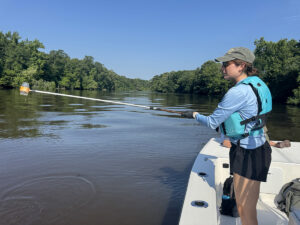News
2 down, 1 to go: Nash Co. stormwater assessments continue at Northern Nash
Environmental, Sound Rivers, Stormwater, Stormwater Issues, Stormwater Restoration Projects, Stormwater Runoff, Tar-Pamlico Watershed
Posted on May 4th, 2023

Environmental engineers will have their work cut out for them at Northern Nash High School.
Sound Rivers’ Program Director Clay Barber, and Kris Bass Engineering engineers Connor Brown and Carmen Tormey visited the school this week, part of a grant process funding studies of three Nash County schools and what stormwater projects they need.
“The campus is very clean, the grounds and the buildings are well-maintained, but it just doesn’t seem like much attention has been paid to stormwater,” Clay said. “I didn’t know before I went, but I think it’s the oldest campus in the county. It was built in in the mid-1960s. There were no permitted stormwater devices in the original design, and they have added and tacked on projects — the drainage is just a hodgepodge of network of retrofits, repairs and rerouting things over and over again.”
The stormwater issues are compounded by the makeup of the soil in the area. Any stormwater projects at Northern Nash will have to be modified to account for the fine, silty clay that doesn’t absorb water well. The campus and surrounding areas drain into Stony Creek, a tributary of the Tar River.

Now it’s up to Clay and the team of environmental engineers to figure out what can be done — and where to start. A few areas stood out, Clay said: areas with open, v-shaped ditches where water moves too quickly and has caused erosion (including road repair in one place); and a playground that floods at a childcare center, which could be helped by a modified rain garden. Clay said he also sees a lot of potential for rainwater-harvesting cisterns on the campus.
Northern Nash High School is second site visit made by Clay and Kris Bass Engineering engineers. The first was to Rocky Mount High School; the last one will be Southern Nash High School. Each site study is being funded by North Carolina’s Environmental Enhancement Grant program.

Related News

Neuse fish kill expected to extend beyond holiday weekend
July 3rd 2025

Swim Guide fails prompt Maple Cypress investigation
July 3rd 2025

Riverkeeper, town partners root out source of Smithfield sediment pollution
July 3rd 2025

Trash trap No. 12 approved for Smithfield
July 3rd 2025

Sunset River Paddle fundraiser boosts Water Quality Fund
July 3rd 2025

Riverkeepers host quarterly Water Watch meeting
July 3rd 2025

Public hearing will determine the fate of many NC wetlands
June 26th 2025

Clayton gets first official trash-trap cleanout
June 25th 2025

